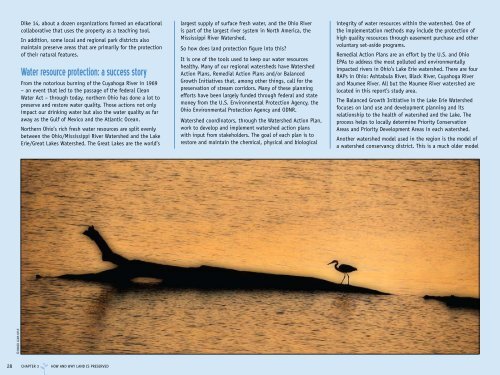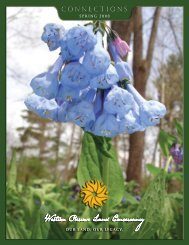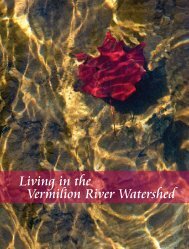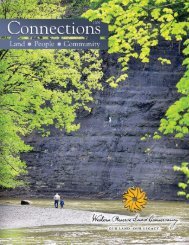Common Ground - Western Reserve Land Conservancy
Common Ground - Western Reserve Land Conservancy
Common Ground - Western Reserve Land Conservancy
You also want an ePaper? Increase the reach of your titles
YUMPU automatically turns print PDFs into web optimized ePapers that Google loves.
© DAVID LIAM KYLE<br />
Dike 14, about a dozen organizations formed an educational<br />
collaborative that uses the property as a teaching tool.<br />
In addition, some local and regional park districts also<br />
maintain preserve areas that are primarily for the protection<br />
of their natural features.<br />
Water resource protection: a success story<br />
From the notorious burning of the Cuyahoga River in 1969<br />
– an event that led to the passage of the federal Clean<br />
Water Act – through today, northern Ohio has done a lot to<br />
preserve and restore water quality. Those actions not only<br />
impact our drinking water but also the water quality as far<br />
away as the Gulf of Mexico and the Atlantic Ocean.<br />
Northern Ohio’s rich fresh water resources are split evenly<br />
between the Ohio/Mississippi River Watershed and the Lake<br />
Erie/Great Lakes Watershed. The Great Lakes are the world’s<br />
28 CHAPTER 3 HOW AND WHY LAND IS PRESERVED<br />
largest supply of surface fresh water, and the Ohio River<br />
is part of the largest river system in North America, the<br />
Mississippi River Watershed.<br />
So how does land protection figure into this?<br />
It is one of the tools used to keep our water resources<br />
healthy. Many of our regional watersheds have Watershed<br />
Action Plans, Remedial Action Plans and/or Balanced<br />
Growth Initiatives that, among other things, call for the<br />
preservation of stream corridors. Many of these planning<br />
efforts have been largely funded through federal and state<br />
money from the U.S. Environmental Protection Agency, the<br />
Ohio Environmental Protection Agency and ODNR.<br />
Watershed coordinators, through the Watershed Action Plan,<br />
work to develop and implement watershed action plans<br />
with input from stakeholders. The goal of each plan is to<br />
restore and maintain the chemical, physical and biological<br />
integrity of water resources within the watershed. One of<br />
the implementation methods may include the protection of<br />
high quality resources through easement purchase and other<br />
voluntary set-aside programs.<br />
Remedial Action Plans are an effort by the U.S. and Ohio<br />
EPAs to address the most polluted and environmentally<br />
impacted rivers in Ohio’s Lake Erie watershed. There are four<br />
RAPs in Ohio: Ashtabula River, Black River, Cuyahoga River<br />
and Maumee River. All but the Maumee River watershed are<br />
located in this report’s study area.<br />
The Balanced Growth Initiative in the Lake Erie Watershed<br />
focuses on land use and development planning and its<br />
relationship to the health of watershed and the Lake. The<br />
process helps to locally determine Priority Conservation<br />
Areas and Priority Development Areas in each watershed.<br />
Another watershed model used in the region is the model of<br />
a watershed conservancy district. This is a much older model









